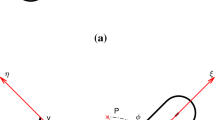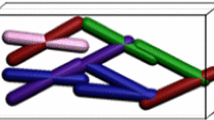Abstract
Despite a solid theoretical foundation and straightforward application to structural design problems, 3D topology optimization still suffers from a prohibitively high computational effort that hinders its widespread use in industrial design. One major contributor to this problem is the cost of solving the finite element equations during each iteration of the optimization loop. To alleviate this cost in large-scale topology optimization, the authors propose a projection-based reduced-order modeling approach using proper orthogonal decomposition for the construction of a reduced basis for the FE solution during the optimization, using a small number of previously obtained and stored solutions. This basis is then adaptively enriched and updated on-the-fly according to an error residual, until convergence of the main optimization loop. The method of moving asymptotes is used for the optimization. The techniques are validated using established 3D benchmark problems. The numerical results demonstrate the advantages and the improved performance of our proposed approach.




















Similar content being viewed by others
Notes
Refining the basis by discarding the older less relevant information in favor of more recent information is a fairly standard strategy, also used by Gogu (2015)
References
Aage N, Lazarov BS (2013) Parallel framework for topology optimization using the method of moving asymptotes. Struct Multidiscip Optim 47(4):493–505. https://doi.org/10.1007/s00158-012-0869-2
Aage N, Andreassen E, Lazarov BS (2015) Topology optimization using PETSc: an easy-to-use, fully parallel, open source topology optimization framework. Struct Multidiscip Optim 51(3):565–572. https://doi.org/10.1007/s00158-014-1157-0
Aage N, Andreassen E, Lazarov B, Sigmund O (2017) Giga-voxel computational morphogenesis for structural design. Nature 550(7674):84–86. https://doi.org/10.1038/nature23911
Alaimo G, Auricchio F, Bianchini I, Lanzarone E (2018) Applying functional principal components to structural topology optimization. Int J Numer Methods Eng 115(2):189–208. https://doi.org/10.1002/nme.5801
Allaire G, Jouve F, Toader A-M (2004) Structural optimization using sensitivity analysis and a level-set method. J Comput Phys 194(1):363–393. https://doi.org/10.1016/j.jcp.2003.09.032
Amir O, Bendsoe MP, Sigmund O (2009) Approximate reanalysis in topology optimization. Int J Numer Methods Eng 78(12):1474–1491. https://doi.org/10.1002/nme.2536
Amir O, Stolpe M, Sigmund O (2010) Efficient use of iterative solvers in nested topology optimization. Struct Multidisc Optim 42(1):55–72. https://doi.org/10.1007/s00158-009-0463-4
Amir O, Sigmund O, Lazarov BS, Schevenels M (2012) Efficient reanalysis techniques for robust topology optimization. Comput Methods Appl Mech Eng 245-246:217–231. https://doi.org/10.1016/j.cma.2012.07.008
Amsallem D, Zahr M, Choi Y, Farhat C (2015) Design optimization using hyper-reduced-order models. Struct Multidiscip Optim 51(4):919–940. https://doi.org/10.1007/s00158-014-1183-y
Bendsoe MP, Sigmund O (2004) Topology optimization: theory, methods and applications. Springer
Bendsoe M (1989) Optimal shape design as a material distribution problem. Struct Optim 1 (193). https://doi.org/10.1007/BF01650949
Berkooz G, Holmes P, Lumley JL (1993) The proper orthogonal decomposition in the analysis of turbulent flows. Annu Rev Fluid Mech 25(1):539–575. https://doi.org/10.1146/annurev.fl.25.010193.002543
Chinesta F, Ladeveze P, Cueto E (2011) A short review on model order reduction based on proper generalized decomposition. Arch Comput Methods Eng 18(4):395. https://doi.org/10.1007/s11831-011-9064-7
Choi Y, Oxberry G, White D, Kirchdoerfer T (2019) Accelerating design optimization using reduced order models. arXiv:https://arxiv.org/abs/1909.11320
Deaton JD, Grandhi RV (2014) A survey of structural and multidisciplinary continuum topology optimization: post 2000. Struct Multidiscip Optim 49(1):1–38. https://doi.org/10.1007/s00158-013-0956-z
Dulong J-L, Druesne F, Villon P (2007) A model reduction approach for real-time part deformation with nonlinear mechanical behavior. Int J Interact Des Manuf (IJIDeM) 1(4):229. https://doi.org/10.1007/s12008-007-0028-y
Dutta S, Ghosh S, Inamdar MM (2018) Optimisation of tensile membrane structures under uncertain wind loads using PCE and kriging based metamodels. Struct Multidiscip Optim 57(3):1149–1161. https://doi.org/10.1007/s00158-017-1802-5
Ferro N, Micheletti S, Perotto S (2019) Pod-assisted strategies for structural topology optimization. Computers & Mathematics with Applications. https://doi.org/10.1016/j.camwa.2019.01.010
Gogu C (2015) Improving the efficiency of large scale topology optimization through on-the-fly reduced order model construction. Int J Numer Methods Eng 101(4):281–304. https://doi.org/10.1002/nme.4797
He JJ, Jiang JS (2012) New method of dynamical reanalysis for large modification of structural topology based on reduced model. In: Manufacturing science and materials engineering, vol. 443 of advanced materials research. Trans Tech Publications, pp 628–631, DOI https://doi.org/10.4028/www.scientific.net/AMR.443-444.628, (to appear in print)
Hoang K, Kerfriden P, Bordas S (2016) A fast, certified and ‘tuning free’ two-field reduced basis method for the metamodelling of affinely-parametrised elasticity problems. Comput Methods Appl Mech Eng 298:121–158. https://doi.org/10.1016/j.cma.2015.08.016
Kirsch U, Bogomolni M (2004) Procedures for approximate eigenproblem reanalysis of structures. Int J Numer Methods Eng 60(12):1969–1986. https://doi.org/10.1002/nme.1032
Kirsch U, Papalambros P (2001) Structural reanalysis for topological modifications – a unified approach. Struct Multidiscip Optim 21(5):333–344. https://doi.org/10.1007/s001580100112
Madra A, Breitkopf P, Raghavan B, Trochu F (2018) Diffuse manifold learning of the geometry of woven reinforcements in composites. Comptes Rendus Mécanique 346(7):532–538. https://doi.org/10.1016/j.crme.2018.04.008
Mahdavi A, Balaji R, Frecker M, Mockensturm EM (2006) Topology optimization of 2D continua for minimum compliance using parallel computing. Struct Multidiscip Optim 32(2):121–132. https://doi.org/10.1007/s00158-006-0006-1
Meng L, Breitkopf P, Quilliec GL, Raghavan B, Villon P (2018) Nonlinear shape-manifold learning approach: concepts, tools and applications. Arch Comput Methods Eng 25(1):1–21. https://doi.org/10.1007/s11831-016-9189-9
Meng L, Breitkopf P, Raghavan B, Mauvoisin G, Bartier O, Hernot X (2019a) On the study of mystical materials identified by indentation on power law and voce hardening solids. Int J Mater Form 12(4):587–602. https://doi.org/10.1007/s12289-018-1436-1
Meng L, Zhang W, Quan D, Shi G, Tang L, Hou Y, Breitkopf P, Zhu J, Gao T (2019b) From topology optimization design to additive manufacturing: today’s success and tomorrow’s roadmap. Archives of Computational Methods in Engineering. https://doi.org/10.1007/s11831-019-09331-1
Norato JA, Bendsøe MP, Haber RB, Tortorelli DA (2007) A topological derivative method for topology optimization. Struct Multidiscip Optim 33(4):375–386. https://doi.org/10.1007/s00158-007-0094-6
Pearson K (1901) LIII. On lines and planes of closest fit to systems of points in space. The London Edinburgh, and Dublin Philosophical Magazine and Journal of Science 2(11):559–572. https://doi.org/10.1080/14786440109462720
Raghavan B, Breitkopf P (2013) Asynchronous evolutionary shape optimization based on high-quality surrogates: application to an air-conditioning duct. Eng Comput 29(4):467–476. https://doi.org/10.1007/s00366-012-0263-0
Raghavan B, Breitkopf P, Tourbier Y, Villon P (2013a) Towards a space reduction approach for efficient structural shape optimization. Struct Multidiscip Optim 48(5):987–1000. https://doi.org/10.1007/s00158-013-0942-5
Raghavan B, Hamdaoui M, Xiao M, Breitkopf P, Villon P (2013b) A bi-level meta-modeling approach for structural optimization using modified pod bases and diffuse approximation. Comput Struct 127:19–28. https://doi.org/10.1016/j.compstruc.2012.06.008
Ryckelynck D, Chinesta F, Cueto E, Ammar A (2006) On thea priori model reduction: overview and recent developments. Arch Comput Methods Eng 13(1):91–128. https://doi.org/10.1007/BF02905932
Saxena A, Ananthasuresh G (2000) On an optimal property of compliant topologies. Struct Multidiscip Optim 19(1):36–49. https://doi.org/10.1007/s001580050084
Senne TA, Gomes FAM, Santos SA (2019) On the approximate reanalysis technique in topology optimization. Optim Eng 20(1):251–275. https://doi.org/10.1007/s11081-018-9408-3
Sigmund O (2001) A 99 line topology optimization code written in matlab. Struct Multidiscip Optim 21 (2):120–127. https://doi.org/10.1007/s001580050176
Sun Y, Zhao X, Yu Y, Zheng S (2018) An efficient reanalysis method for topological optimization of vibrating continuum structures for simple and multiple eigenfrequencies. Math Probl Eng 2018:1–10
Svanberg K (1987) The method of moving asymptotes—a new method for structural optimization. Int J Numer Methods Eng 24(2):359–373. https://doi.org/10.1002/nme.1620240207
Svanberg K (2002) A class of globally convergent optimization methods based on conservative convex separable approximations. SIAM J Optim 12(2):555–573. https://doi.org/10.1137/S1052623499362822
Tatebe O (1993) The multigrid preconditioned conjugate gradient method. Langley Research Center, The Sixth Copper Mountain Conference on Multigrid Methods, Part 2; pp. 621–634
Wang S, Sturler Ed, Paulino GH (2007) Large-scale topology optimization using preconditioned Krylov subspace methods with recycling. Int J Numer Methods Eng 69(12):2441–2468. https://doi.org/10.1002/nme.1798
Xia L, Breitkopf P (2014) Concurrent topology optimization design of material and structure within FE2 nonlinear multiscale analysis framework. Comput Methods Appl Mech Eng 278:524–542. https://doi.org/10.1016/j.cma.2014.05.022
Xia L, Breitkopf P (2017) Recent advances on topology optimization of multiscale nonlinear structures. Arch Comput Methods Eng 24(2):227–249. https://doi.org/10.1007/s11831-016-9170-7
Xia L, Da D, Yvonnet J (2018) Topology optimization for maximizing the fracture resistance of quasi-brittle composites. Comput Methods Appl Mech Eng 332:234–254. https://doi.org/10.1016/j.cma.2017.12.021
Xiao M, Breitkopf P, Coelho RF, Knopf-Lenoir C, Sidorkiewicz M, Villon P (2009) Model reduction by CPOD and Kriging. Struct Multidiscip Optim 41(4):555–574. https://doi.org/10.1007/s00158-009-0434-9
Xiao M, Zhang G, Breitkopf P, Villon P, Zhang W (2018) Extended co-Kriging interpolation method based on multi-fidelity data. Appl Math Comput 323:120–131. https://doi.org/10.1016/j.amc.2017.10.055
Yin L, Yang W (2001) Optimality criteria method for topology optimization under multiple constraints. Comput Struct 79(20):1839–1850. https://doi.org/10.1016/S0045-7949(01)00126-2
Yoon GH (2010) Structural topology optimization for frequency response problem using model reduction schemes. Comput Methods Appl Mech Eng 199(25):1744–1763. https://doi.org/10.1016/j.cma.2010.02.002
Zheng S, Zhao X, Yu Y, Sun Y (2017) The approximate reanalysis method for topology optimization under harmonic force excitations with multiple frequencies. Struct Multidiscip Optim 56(5):1185–1196. https://doi.org/10.1007/s00158-017-1714-4
Zhou Y, Zhang W, Zhu J (2019) Concurrent shape and topology optimization involving design-dependent pressure loads using implicit b-spline curves. Int J Numer Methods Eng 118 (9):495–518. https://doi.org/10.1002/nme.6022
Acknowledgments
The first and third author formally acknowledge the contribution of their Masters student Mr. Jin Wentao, Huawei inc. to this work. The third and fourth author express their sincere gratitude to Mr. Tabrej Alam, Masters student at NIT Silchar for his help in testing the codes in its initial stages.
Funding
This multi-national research study was supported by the National Natural Science Foundation of China (Grant No. 11620101002 and Grant No. 11972166) and the Fundamental Research Funds for the Central Universities (Grant No. 310201911cx029).
Author information
Authors and Affiliations
Corresponding author
Ethics declarations
Conflict of interest
The authors declare that they have no conflict of interest.
Replication of results
The source codes in this work are an evolution of the 88-line Matlab code, according to the proposed methodology, along with the definition of test cases, which allow to reproduce the numerical results presented in this paper. These codes could be made available on request by emailing the corresponding author.
Additional information
Responsible Editor: Fred van Keulen
Publisher’s note
Springer Nature remains neutral with regard to jurisdictional claims in published maps and institutional affiliations.
Rights and permissions
About this article
Cite this article
Xiao, M., Lu, D., Breitkopf, P. et al. On-the-fly model reduction for large-scale structural topology optimization using principal components analysis. Struct Multidisc Optim 62, 209–230 (2020). https://doi.org/10.1007/s00158-019-02485-3
Received:
Revised:
Accepted:
Published:
Issue Date:
DOI: https://doi.org/10.1007/s00158-019-02485-3




